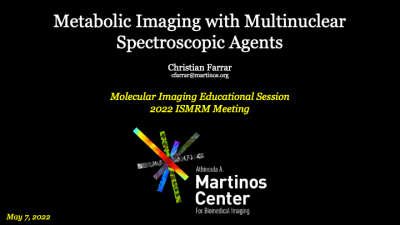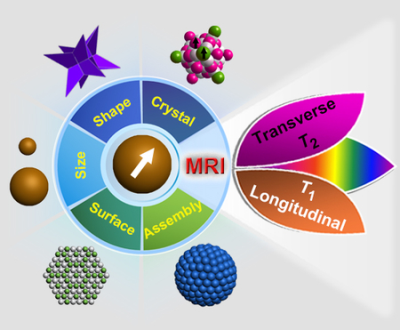Weekend Course
Molecular Imaging
Joint Annual Meeting ISMRM-ESMRMB & ISMRT 31st Annual Meeting • 07-12 May 2022 • London, UK

| CEST Agents | |||
| 08:00 | CEST I: from basic mechanism to applications
Iris Zhou
CEST MRI is an emerging molecular imaging technique that allows sensitive detection of endogenous or exogenous molecules containing exchangeable protons. CEST imaging has been demonstrated in mapping low-concentration metabolites and microenvironment properties in various organs and diseases, promising in a host of in vivo applications and translation to humans. A deeper understanding of the underlying CEST contrast mechanism, imaging approaches, and quantification methods allows extracting particular signal components of interest, and thus, the improvement of specificity.
|
||
| 08:25 | CEST II
Amnon Bar Shir
Label-free (and metal-free) molecular probes developed for molecular and cellular CEST imaging provide with unprecedented versatility to design them for monitoring a wide range of biological events. Here, the principles upon which a novel CEST probe should be based on will be discussed and examples of established, well-studied probes as well as recently developed ones will be presented. Moreover, the combination of 19F-MRI and CEST-MRI to obtain a new type of contrast, 19F-CEST, will be highlighted and discussed. Although CEST based probes should be further developed, their performances have already demonstrated their contribution to advance molecular and cellular MR imaging.
|
||
| Paramagnetic Agents | |||
| 08:50 | Paramagnetic Agents I
Eric Gale
MRI using targeted molecular probes enables non-invasive diagnosis, quantification, and longitudinal monitoring of the cell- and molecular-level determinants driving disease. However, developing a molecular MR imaging probe is challenging. MR imaging probes are detected with low sensitivity and overcoming this limitation is paramount amongst the challenges to probe development. This talk describes the molecular mechanisms underpinning paramagnetic relaxation enhancement and how these parameters may be tweaked for imaging probe optimization. The talk is designed for an audience that understand T1 and T2 relaxation and how these properties relate to image contrast.
|
||
| 09:15 | Paramagnetic Agents II
Veronica Clavijo Jordan
Optimal detection of targeted paramagnetic molecular probes in vivo by MRI rely on multiple factors. Largely the optimization of its chemical and biophysical characteristics, interaction with the desired target, biodistribution, etc. In this talk we will introduce a clinical case to emphasize the use case of a targeted molecular probe and discuss the key aspects for detection from an applications perspective. We will introduce and compare a variety of molecular probes that have proven successful at detecting a target in vivo. Furthermore, this talk will tie in considerations for clinical applications and the path to translation.
|
||
| 09:40 | Break & Meet the Teachers |
||
| Spectroscopic Agents | |||
| 10:05 |  |
Metabolic Imaging with Multinuclear Spectroscopic Agents
Christian Farrar
Metabolic imaging can provide key insights into disease mechanisms and therapeutic response at much earlier time points than anatomical imaging. While multinuclear magnetic resonance spectroscopy of 13C-, 15N- or 2H-labeled spectroscopic agents can provide high specificity for the detection of different metabolic products, with no background signal and well resolved metabolic signatures, it suffers from low sensitivity. The low sensitivity can be overcome with hyperpolarization or by rapid averaging of signals from deuterated spectroscopic agents with short T1. In this presentation we will review different methods and challenges for detecting multinuclear spectroscopic agents and their application to metabolic imaging.
|
|
| 10:30 | 129Xe & 19F Multinuclear MR Molecular Imaging
Xin Zhou
Multi-nuclear MRI technology extends clinical 1H MR imaging to multi-nuclei imaging of lungs and other organs. Aiming at the great demand of early diagnosis of lung and brain critical diseases, we have constructed high sensitivity, high specificity, and environment responsive molecular probes, which uses 129Xe/19F/1H multi-nuclear magnetic resonance enhancement technology. Furthermore, through the multi-modal and multi-scale study of lung cancer molecular function, cell behavior, in vivo lesions to human lung function, it provides a theoretical basis for the transformation of high-sensitive 129Xe/19F/1H multi-nuclear magnetic resonance molecular imaging in basic research to clinical.
|
||
| Superparamagnetic/Nanoscale Agents | |||
| 10:55 | Superparamagnetic/Nanoscale Agents I Video Permission Withheld
Jeff Bulte
As compared to other molecular imaging techniques MRI l has a notorious low sensitivity. One way to increase sensitivity is increasing the payload of MRI contrast agents (paramagnetic and/or superparamagnetic agents) or tracers (perfluorocarbons) in the form of nanoparticles. I will discuss some of the latest directions in the design and use of nanoscale MR imaging agents, including the use of diaCEST agents, multi-spectral agents, pH imaging agents, and functional agents sensing the tumor microenvironment. I will also discuss how certain MRI studies are now being duplicated using MPI, and review the advantages and disadvantages from a clinical perspective.
|
||
| 11:20 |  |
Magnetotheranostics
Xiaoyuan Chen
Theranostics is a fast-growing field due to demands for new, efficient therapeutics which could be precisely delivered to the target site using multimodal imaging with enhancing auxiliary actions. In this talk we discuss theranostic nanoplatforms containing magnetic nanoparticles along with other components. Magnetic nanoparticles allow for both diagnostic and therapeutic capabilities. We focus on the most important design strategies to achieve optimal theranostic effects as well as the roles of different components included in theranostics.
|
|
The International Society for Magnetic Resonance in Medicine is accredited by the Accreditation Council for Continuing Medical Education to provide continuing medical education for physicians.